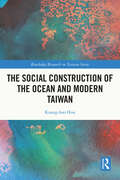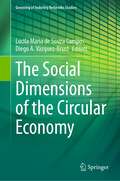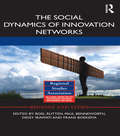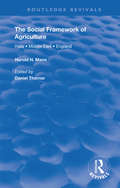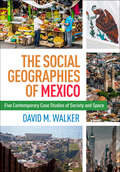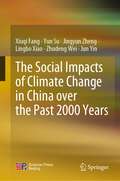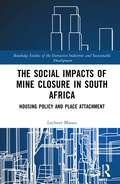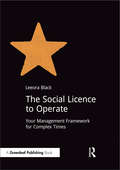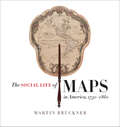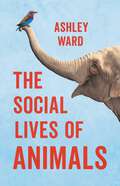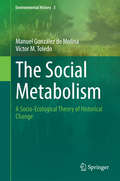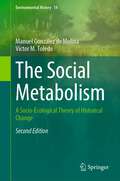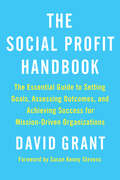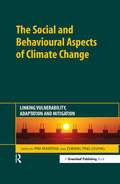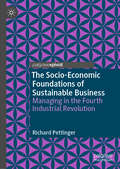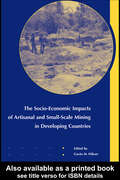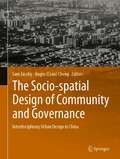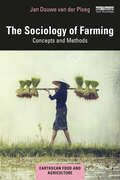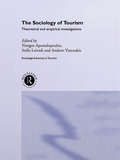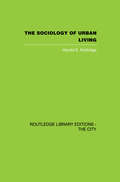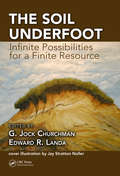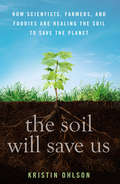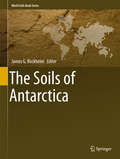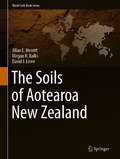- Table View
- List View
The Social Construction of the Ocean and Modern Taiwan (Routledge Research on Taiwan Series)
by Kuang-hao HouThis book interprets the meanings of the uses, regulations, and representations of the ocean undertaken by the state and other societal power sources in modern Taiwan between 1949 and 2016. Following Michael Mann’s historical sociology and Philip Steinberg’s political geography, the book analyses the construction of the ocean by the society of Taiwan in terms of ideological, political, military and economic sources of power. It also provides a structural foundation for creating a framework of the politics in maritime and ocean affairs through the lens of an interpretive analysis of the modern Taiwanese construction of the ocean. Moreover, it explores the social constructions of the ocean through the written works of intellectuals in natural sciences, social studies and humanities in Taiwan after the 1980s. Succinctly revealing how Taiwanese society has influenced the social construction of the ocean, this book will appeal to scholars and students interested in Taiwanese politics and history, political geography and Asian politics.
The Social Dimensions of the Circular Economy (Greening of Industry Networks Studies #10)
by Lucila Maria de Souza Campos Diego A. Vázquez-BrustThe main theme of this book is the social dimension of the circular economy (CE). This book’s objective is to provide a foundation for the discussion of social aspects of CE that also allows the integration of CE with the UN SDGs. The circular economy is increasingly becoming the consensual pathway for a transition towards sustainable production and consumption that balances the economic and ecological pillars of sustainable development. However, researchers have noted that the social dimension of sustainable development is noticeable missing or, at best, weakly developed in CE ideas and frameworks (Sehnem et al., 2019). The main argument of this book is that CE research and practice needs to embrace its social impacts, not only in terms of understanding and avoiding negative social impacts but also in terms of exploring the potential that CE models have for addressing social challenges.
The Social Dynamics of Innovation Networks (Regions and Cities)
by Roel Rutten Paul Benneworth Dessy Irawati Frans BoekemaThe social dynamics of innovation networks captures the important role of trust, social capital, institutions and norms and values in the creation of knowledge in innovation networks. In doing so, this book connects to a long-standing debate on the socio-spatial context of innovation in economic geography, which is usually referred to as the Territorial Models of Innovation (TIMs) literature. This present volume breaks with the TIM literature in several important ways. In the first place, this book emphasizes the role of individual agency because individuals and their networks are increasingly recognized as the principal agents of knowledge creation. Secondly, this volume looks at space as a continuous field of opportunity rather than as bounded territory with a set of endowments, such as knowledge base and social capital. Although individually these elements are not new to the TIM literature, it has thus far failed to grasp their critical implication for studying the social dynamics of innovation networks. The approach to the socio-spatial context of innovation in this volume is summarized as Knowledge Economy 2.0. It emphasizes that human creativity is now the main source of economic value and that human creativity and knowledge creation is not an organized process within organizations, but happens bottom up in formal and informal professional and social networks of individuals that cut across multiple organizations.
The Social Framework of Agriculture (Routledge Revivals)
by Harold H. MannPublished in 1968: The author not only pioneered modern-style village surveys in both England and India, but also modern style urban surveys and studies in India. There he broke new ground in his remarkable first-hand researches on agricultural labour, village economics, depressed or "Untouchable" classes in town and country, and human and industrial relations in India’s first steel town, Jamshedpur. In the text of this book we reproduce thirty-five of the author’s papers – in whole, in part, or in summary.
The Social Geographies of Mexico: Five Contemporary Case Studies of Society and Space
by David M. WalkerExamining the links between society, space, and place, this unique text introduces students to the ecological and cultural richness of Mexico and the diversity, tenacity, and resilience of its people. David M. Walker presents compelling ethnographic case studies of Mexico City's historic center and the adjacent Tepito neighborhood; life in the border city of Tijuana; and urban Mexican garbage networks. Cases also explore Afromexican identity in the Costa Chica of Guerrero and Oaxaca, as well as the Indigeneous Zoque people's stewardship of the remote Chimalapas region. Readers are immersed in the stories of real individuals and their livelihood strategies; natural and built environments; values and faith practices; leisure activities; foodways; involvements in local to global cultural, political, and economic processes; and more. Instructive features include topical vignettes, discussion questions, and suggested readings and online resources related to each case.
The Social Impacts of Climate Change in China over the Past 2000 Years
by Jun Yin Xiuqi Fang Yun Su Jingyun Zheng Lingbo Xiao Zhudeng WeiThis book aims to illustrate how climate change had impacted the socio-economic development in the history of China, under the framework of food security. The 10 years resolution sequences indexing the status of social and economic subsystems in China over the past 2000 years are reconstructed. Statistical methods are used to reveal the major characters and main process of the impact of historical climate change on China's social economy. This book serves as a reference both for researchers, graduates, and undergraduates majoring in geography, climatology, history, and other related fields.
The Social Impacts of Mine Closure in South Africa: Housing Policy and Place Attachment (Routledge Studies of the Extractive Industries and Sustainable Development)
by Lochner MaraisThis book investigates the relationship between mining, mine closure and housing policy in post-apartheid South Africa, using concepts from new institutional economics and evolutionary governance theory. Mine closures present a major challenge to the mining industry and governments, with this being particularly noticeable in the Global South. This book argues that the dependencies created by the mining industry and mine housing policies while a mine is operational cause serious societal problems when it closes. To demonstrate this, the book applies the concepts of place attachment, asset-based development and social disruption. Conceptually, the book challenges the view that place attachment and asset-based development are the most appropriate and often the only policy responses in mining areas. In South Africa, the mining industry and the government have created comprehensive housing programmes linked to homeownership to promote place attachment, stability and wealth among mine workers. These programmes do not consider the disruption that mine closure might bring. The book challenges the blind application, during boom periods, of policies which create long-term dependencies that are difficult to manage when a mine closes. This book will be of interest to students and scholars researching the social impacts of mining and the extractive industries, social geography and sustainable development, as well as policymakers and practitioners working with mine closure or social impact assessments.
The Social Licence to Operate: Your Management Framework for Complex Times (DoShorts)
by Leeora BlackThe "social licence to operate" began as a metaphor to bring attention to the need for companies to earn acceptance from their host communities. Today, it is a necessary management framework for complex times.A social licence strategy is essentially a stakeholder engagement strategy for navigating complex socio-political environments. This book provides the framework, tools and case studies a company needs to create a foundation for truly sustainable community development.This 90-minute guide will enable you to: define the social licence to operate; make the business case for actively managing your social licence to operate; measure the social licence to operate; develop a step-by-step plan to restore, build, maintain and enhance your company’s social licence; and report on your social licence.This book is for managers in any company facing rising social scrutiny due to unwanted social or environmental impacts. You may be working in natural resources, renewable energy, oil and gas, forestry, construction, manufacturing, retail, food processing, pharmaceuticals or any industry that is facing rising stakeholder expectations and increasing criticism.
The Social Life of Maps in America, 1750-1860 (Published by the Omohundro Institute of Early American History and Culture and the University of North Carolina Press)
by Martin BrücknerIn the age of MapQuest and GPS, we take cartographic literacy for granted. We should not; the ability to find meaning in maps is the fruit of a long process of exposure and instruction. A "carto-coded" America--a nation in which maps are pervasive and meaningful--had to be created. The Social Life of Maps tracks American cartography's spectacular rise to its unprecedented cultural influence. Between 1750 and 1860, maps did more than communicate geographic information and political pretensions. They became affordable and intelligible to ordinary American men and women looking for their place in the world. School maps quickly entered classrooms, where they shaped reading and other cognitive exercises; giant maps drew attention in public spaces; miniature maps helped Americans chart personal experiences. In short, maps were uniquely social objects whose visual and material expressions affected commercial practices and graphic arts, theatrical performances and the communication of emotions. This lavishly illustrated study follows popular maps from their points of creation to shops and galleries, schoolrooms and coat pockets, parlors and bookbindings. Between the decades leading up to the Revolutionary War and the Civil War, early Americans bonded with maps; Martin Bruckner's comprehensive history of quotidian cartographic encounters is the first to show us how.
The Social Lives of Animals
by Ashley WardA rat will go out of its way to help a stranger in need. Lions have adopted the calves of their prey. Ants farm fungus in cooperatives. Why do we continue to believe that life in the animal kingdom is ruled by competition? In The Social Lives of Animals, biologist Ashley Ward takes us on a wild tour across the globe as he searches for a more accurate picture of how animals build societies. Ward drops in on a termite mating ritual (while his guides snack on the subjects), visits freelance baboon goatherds, and swims with a mixed family of whales and dolphins. Along the way, Ward shows that the social impulses we&’ve long thought separated humans from other animals might actually be our strongest connection to them. Insightful, engaging, and often hilarious, The Social Lives of Animals demonstrates that you can learn more about animals by studying how they work together than by how they compete.
The Social Metabolism
by Víctor M. Toledo Manuel González de MolinaOver this last decade, the concept of Social Metabolism has gained prestige as a theoretical instrument for the required analysis, to such an extent that there are now dozens of researchers, hundreds of articles and several books that have adopted and use this concept. However, there is a great deal of variety in terms of definitions and interpretations, as well as different methodologies around this concept, which prevents the consolidation of a unified field of new knowledge. The fundamental aim of the book is to conduct a review of the past and present usage of the concept of social metabolism, its origins and history, as well as the main currents or schools that exist around this concept. At the same time, the reviews and discussions included are used by the authors as starting points to draw conclusions and propose a theory of socio-ecological transformations. The theoretical and methodological innovations of this book include a distinction of two types of metabolic processes: tangible and intangible; the analysis of the social metabolism at different scales (in space and time) and a theory of socio-ecological change overcoming the merely "systemic" or "cybernetic" nature of conventional approaches, giving special protagonism to collective action.
The Social Metabolism: A Socio-Ecological Theory of Historical Change (Environmental History #14)
by Víctor M. Toledo Manuel González de MolinaThis book helps readers to understand the fast growing and timely concept of social metabolism. The authors shed a light on the different existing terms and methodologies that have been developed over the years. Through the study of history, readers will get an understanding of the main currents or schools that exist around this concept and their main findings. Also provides examples of how to apply the metabolic approach at different territorial and temporal scales and using different methodological tools. The book presents a novel socio-metabolic theory of historical change, in which biophysical and social variables are combined in an integrated way to understand the dynamics of socio-metabolic transitions.In this second edition, the authors provide valuable updates and new sections to each of the previous chapters. New insights on global phenomena like climate change and the environmental crisis are also considered. As readers will learn, a paradigm shift in almost all areas of research and society will be needed to face the challenges created by the modern industrial society. The authors use a look back in history, to explore the relationship between humans and nature from an evolutionary and thermodynamic perspective. With this approach, readers from history, environmental sciences and social sciences will get valuable insights on possible solutions.
The Social Profit Handbook: The Essential Guide to Setting Goals, Assessing Outcomes, and Achieving Success for Mission-Driven Organizations
by David GrantHow to articulate and assess what success looks likeThe Social Profit Handbook offers those who lead, govern, and support mission-driven organizations and businesses new ways to assess their impact in order to improve future work rather than merely judge past performance.For-profit institutions measure their success primarily by monetary gains. But nonprofit institutions are different; they aim for social profit. How do you measure the success of these social profit institutions, where missions are focused on the well-being of people, place, and planet?Drawing upon decades of leadership in schools and the foundation and nonprofit worlds, author David Grant offers strategies—from creating mission time to planning backwards to constructing qualitative assessment rubrics—that help organizations take assessment back into their own hands, and improve their work as a result. His insights, illustrated by numerous case studies, make this book a unique organizational development tool for a wide range of nonprofit organizations, as well as emerging mission-based social venture businesses, such as low-profit corporations and B Corps.The Social Profit Handbook presentsassessment and evaluation not as ends in themselves but as the path toward achieving what matters most in the social sector. The result: more benefits to society and stronger, more unified, more effective organizations prepared to make the world a better place.
The Social and Behavioural Aspects of Climate Change: Linking Vulnerability, Adaptation and Mitigation
by Pim Martens Chiung Ting ChangOver the past few years, and certainly since the publication of the "Stern Report", there has been increasing recognition that climate change is not only an environmental crisis, but one with important social and economic dimensions. There is now a growing need for multi-disciplinary research and for the science of climate change to be usefully translated for policy-makers.Until very recently, scientific and policy emphasis on climate change has focused almost exclusively on mitigation efforts: mechanisms and regulations to reduce greenhouse gas emissions. The success of such efforts to date is debatable. In fact, the impact of ever more stringent emission control programmes could potentially have enormous social consequences. Little effort has been expended on the exploration of a systematic evaluation of climate stabilization benefits or the costs of adapting to a changed climate, let alone attempting to integrate different approaches. There is an increasing recognition that the key actors in the climate crisis also need to be preparing for change that is unavoidable. This has resulted in a greater consideration of vulnerability and adaptation.The book, based on the research programme "Vulnerability, Adaptation and Mitigation" (VAM) which ran from 2004 to 2010, funded by the Netherlands Organisation for Scientific Research (NWO), presents a cluster of case studies of industries, communities and institutions which each show how vulnerability, adaptation and mitigation analyses can be integrated using social behavioural sciences. Each chapter makes specific recommendations for the studied industry sector, community or institution, analyses the latest research developments of the field and identifies priorities for future research. The book argues that the inherent complexity of climate change will ultimately require a much more integrated response both scientifically – to better understand multiple causes and impacts – as well as at the scientific/policy interface, where new forms of engagement between scientists, policy-makers and wider stakeholder groups can make a valuable contribution to more informed climate policy and practice.The book is particularly timely as the scientific research and policy debate is shifting from one of problem-framing to new agendas that are much more concerned with implementation, the improvement of assessment methodologies from a multi-disciplinary perspective, and the reframing of current scientific understanding towards mitigation, adaptation and vulnerability. A critical element in responding to the climate change challenge will be to ensure the translation of these new scientific insights into innovative policy and practice "on the ground". This book provides some fundamental elements to answer this need.The Social and Behavioural Aspects of Climate Change: Linking Vulnerability, Adaptation and Mitigation will be essential reading for social science researchers and policy managers in the area of climate change, as well as for those who want to know what the social and behavioural sciences can contribute toward coping with climate hazards. NGOs, law firms and businesses in the energy sector or other climate related fields will also find the book of great value.
The Socio-Economic Foundations of Sustainable Business: Managing in the Fourth Industrial Revolution
by Richard PettingerThis book brings together key aspects of contemporary organisations with regard to the socio-economic foundations of sustainable business. We are now in the middle of the Fourth Industrial Revolution; an unprecedented development in technology and society, driven by social, political and economic demands. The Fourth Industrial Revolution is affecting business, but also has social consequences, as can be seen in the present and evolving patterns of economic activity. In turn, these consequences influence and create crucial and central issues regarding value, sustainability, security and assurance – aspects required and demanded by all areas of society.Based on work assessing the US and UK business sectors, including research conducted at the UCL in conjunction with such diverse organisations as the Bank of England, Google, Facebook and the Antwerp Diamond Exchange, this book addresses the key issues and challenges involved in integrating real and virtual environments. In addition, it uses case studies to illustrate the academic theory, blending industry and scholarly literature.Written by an expert in his field, this book delivers a realistic, practical and academically sound foundation for business, management and organisation studies, while also providing an interdisciplinary view on a transforming society, incorporating technology, IT, economics and sociology.
The Socio-Economic Impacts of Artisanal and Small-Scale Mining in Developing Countries
by Gavin M. HilsonThe purpose of this book is to examine both the positive and negative socioeconomic impacts of artisanal and small-scale mining in developing countries. In recent years, a number of governments have attempted to formalize this rudimentary sector of industry, recognizing its socioeconomic importance. However, the industry continues to be plagued by
The Socio-spatial Design of Community and Governance: Interdisciplinary Urban Design in China
by Sam Jacoby Jingru Cyan ChengThis book proposes a new interdisciplinary understanding of urban design in China based on a study of the transformative effects of socio-spatial design and planning on communities and their governance. This is framed by an examination of the social projects, spaces, and realities that have shaped three contexts critical to the understanding of urban design problems in China: the histories of “collective forms” and “collective spaces”, such as that of the urban danwei (work-unit), which inform current community building and planning; socio-spatial changes in urban and rural development; and disparate practices of “spatialised governmentality”. These contexts and an attendant transformation from planning to design and from government to governance, define the current urban design challenges found in the dominant urban xiaoqu (small district) and shequ (community) development model. Examining the histories, transformations, and practices that have shaped socio-spatial epistemologies and experiences in China – including a specific sense of community and place that is rather based on a concrete “collective” than abstract “public” space and underpinned by socialised governance – this book brings together a diverse range of observations, thoughts, analyses, and projects by urban researchers and practitioners. Thereby discussing emerging interdisciplinary urban design practices in China, this book offers a valuable resource for all academics, practitioners, and stakeholders with an interest in socio-spatial design and development.
The Sociology of Energy, Buildings and the Environment: Constructing Knowledge, Designing Practice
by Elizabeth Shove Simon GuyBringing the social sciences to the heart of environmental debate, this book demonstrates the relevance of sociological analysis for environmentally critical issues like energy consumption. Focusing on energy efficiency and the built environment, the authors take a critical look at the production and use of technical knowledge and energy-related expertise. Challenging the conventional assumptions of scientists and energy policy-makers, the book outlines a new role for social research and a new paradigm for environmental policy.
The Sociology of Farming: Concepts and Methods (Earthscan Food and Agriculture)
by Jan Douwe van der PloegThis book provides a detailed and comprehensive introduction to the concepts and methods of the sociology of farming. The sociology of farming focuses on co-production: the ongoing interaction and mutual transformation of the natural and the social (of ‘human and living nature’) which requires putting the farm labour process centre stage. While there are many books which discuss food and agriculture, this book is different: it delves into the methods and concepts used and presents a comprehensive conceptual framework and the associated methods for research to give students and researchers of agriculture and rural studies a solid set of tools for unravelling the complexities of farming and rural life. Importantly, these tools also empower us to design new ways forward. A wide array of case studies, as wide-ranging as Brazil, Peru, China, the Netherlands, Italy and Guinea Bissau, help readers to grasp the commonalities that underlie strongly diversified and divided rural worlds. The book lists over two hundred basic concepts and includes boxes that discuss the main methods of the sociology of farming. This textbook is essential reading for students and scholars of food and agriculture, agrarian studies, rural development, food and farming systems, peasant studies and environmental sociology.
The Sociology of Tourism: Theoretical and Empirical Investigations (Routledge Advances in Tourism #Vol. 1)
by Yiorgos Apostolopoulos Stella Leivadi Andrew YiannakisThe rapid expansion of the tourism industry has provided many economic benefits and affected every facet of contemporary societies including employment, government revenue and cultural manifestations. However, tourism can also be considered a problematic phenomenon, promoting dependency, underdevelopment and adverse sociocultural effects, especially for developing countries. This pioneering work provides a comprehensive review of these complex tourism issues from a sociological perspective. Various theoretical and empirical approaches are introduced and the following issues are discussed: * identifiable and stable forms of touristic behaviour and roles* social divisions within tourism* the interdependence of tourism and social institutions* the effects of transnational tourism and commodification on the ecosystem.Featuring international contributions from nine different countries, this book brings together the most noted theoretical and empirical studies and enriches them with diverse experiences and perspectives.
The Sociology of Urban Living
by Harold E. NottridgeThe urban setting in which people live has an important influence upon the organization and planning of their social lives. H. E. Nottridge here presents a valuable introduction to the field of urban sociology, showing that it is a theoretical discipline which is worthy of consideration in its own right. Throughout his account Mr Nottridge places strong emphasis on the need for comparative perspectives. He uses a wide range of source material from urban environments as far apart as shanty towns in developing countries and the great metropolitan complexity of London. He covers such topics as scope and methods in urban sociology, social differences in towns and , in the context of urban social structure, the family and network theories. He also analyses the work of the Chicago School of Weber, Tonnies, Park, Redfield and Wirth, assessing their value for mdoern urban sociology. The author concludes with an examination of housing, migration and urban poverty. This book was first published in 1972.
The Soil Underfoot: Infinite Possibilities for a Finite Resource
by Edward R. Landa G. Jock ChurchmanThe largest part of the world's food comes from its soils, either directly from plants, or via animals fed on pastures and crops. Thus, it is necessary to maintain, and if possible, improve the quality-and hence good health-of soils, while enabling them to support the growing world population. The Soil Underfoot: Infinite Possibilities for a Finite
The Soil Will Save Us: How Scientists, Farmers, and Foodies Are Healing the Soil to Save the Planet
by Kristin OhlsonThousands of years of poor farming and ranching practices—and, especially, modern industrial agriculture—have led to the loss of up to 80 percent of carbon from the world's soils. That carbon is now floating in the atmosphere, and even if we stopped using fossil fuels today, it would continue warming the planet. In The Soil Will Save Us, journalist and bestselling author Kristin Ohlson makes an elegantly argued, passionate case for "our great green hope"—a way in which we can not only heal the land but also turn atmospheric carbon into beneficial soil carbon—and potentially reverse global warming.As the granddaughter of farmers and the daughter of avid gardeners, Ohlson has long had an appreciation for the soil. A chance conversation with a local chef led her to the crossroads of science, farming, food, and environmentalism and the discovery of the only significant way to remove carbon dioxide from the air—an ecological approach that tends not only to plants and animals but also to the vast population of underground microorganisms that fix carbon in the soil. Ohlson introduces the visionaries—scientists, farmers, ranchers, and landscapers—who are figuring out in the lab and on the ground how to build healthy soil, which solves myriad problems: drought, erosion, air and water pollution, and food quality, as well as climate change. Her discoveries and vivid storytelling will revolutionize the way we think about our food, our landscapes, our plants, and our relationship to Earth.
The Soils of Antarctica
by James G. BockheimThis book divides Antarctica into eight ice-free regions and provides information on the soils of each region. Soils have been studied in Antarctica for nearly 100 years. Although only 0. 35% (45,000 km2) of Antarctica is ice-free, its weathered, unconsolidated material qualify as "soils" Soils of Antarctica is richly illustrated with nearly 150 images and provisional maps are provided for several key ice-free areas.
The Soils of Aotearoa New Zealand (World Soils Book Series)
by Allan E. Hewitt Megan R. Balks David J. LoweThis book offers an introduction to the soils of Aotearoa New Zealand, structured according to the New Zealand soil classification system. Starting with an overview of the importance and distribution of New Zealand soils, it subsequently provides essential information on each of the 15 New Zealand soil orders in separate chapters. Each chapter, illustrated with diagrams and photographs in colour, includes a summary of the main features of the soils in the order, their genesis and relationships with landscapes, their key properties including examples of physical and chemical characteristics, and their classification, use, and management. The book then features a chapter on soils in the Ross Sea region of Antarctica and concludes by considering New Zealand soils in a global context, soil-formation pathways, and methods used in New Zealand to evaluate soils and assist in land-management decisions. Information about how to access detailed information via links to the Manaaki Whenua Landcare Research website is also included.
